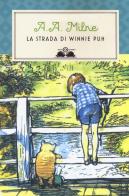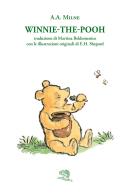
Vini-der-Pu Winnie-the-Pooh in Yiddish A Translation of A. A. Milne's Winnie-the-Pooh
- Editore:
Ishi Press
- Traduttore:
- Wolf, Dr Leonard
- EAN:
9784871872058
- ISBN:
487187205X
- Pagine:
- 78
- Formato:
- Paperback
- Lingua:
- Giapponese
Descrizione Vini-der-Pu Winnie-the-Pooh in Yiddish A Translation of A. A. Milne's Winnie-the-Pooh
Winnie-the-Pooh is the most popular children's book in the world. Previously, Yiddish had been thought of as a dead or dying language. However, now Yiddish is a growing language of increasing importance. This is especially true of Eastern Yiddish, a language of the Ukraine, where it is growing in importance in Brooklyn in the United States. Yiddish is a language read and spoken by nearly two million people world-wide. In New York City there are six Yiddish Language newspapers. Yiddish generally uses the Hebrew alphabet written right to left. However, the author here, Leonard Wolf, chose to write it in the Roman or Latin Alphabet, writing left to right, obviously for the ease of children and new readers.Ishi Press has reprinted translations of Winnie-the-Pooh into 24 languages thus far. We have published it in Armenian, Bengali, Bulgarian, Chinese, Croatian, Danish, Dutch, Esperanto, Finnish, German, Greek, Hungarian, Icelandic, Italian, Korean, Persian, Polish, Russian, Spanish, Hindi, Urdu, Khowar, Kalasha and Latin. We have six more languages lined up. This publication of a translation into Yiddish is part of project to translate Winnie-the-Pooh into other languages. The idea is children need to learn to read at an early age and the best way to teach them to read is to provide reading materials that they find interesting. Children around the world laugh when they see Winnie-the-Pooh saying and doing silly things. Since Winnie-the-Pooh is the most popular children's book world-wide, translating this book into the different languages of the world will be conducive to teaching children to read in those languages. Translations are always difficult. A word in any language will almost never have exactly the same meaning in another language. For example, at the beginning of the English Language original of Winnie-the-Pooh, on the third page there is the following sentence, "He came to a sandy bank and in the bank was a large hole." Now you may be wondering, "Was that because somebody has robbed the bank?" Of course, you know the answer. The bank has not been robbed. But if your translator is somebody not familiar with the banking system, he may not provide the proper translation to this sentence. We are not translating the entire book. We are only translating Chapter 2, which is the most interesting, most popular and shortest chapter. Winnie-the-Pooh is based on the most popular children's character in the world. Part of the reason for this is Winnie-the-Pooh was based on an actual living bear in the London Zoo named Winnie. Christopher Robin is the name of a real person who was the son of the original author, A. A. Milne. The son had a teddy bear he liked to carry around with him he named Winnie-the-Pooh.




